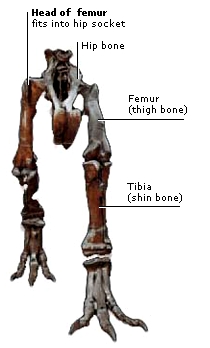DK Science: What Is A Dinosaur?
In the middle of the 19th century, the first fossil skeletons of some extraordinary creatures were unearthed. These skeletons are of the dinosaurs – prehistoric reptiles that have captured the imaginations of people ever since. Dinosaurs, which means “terrible lizards”, ruled the world for more than 160 million years before they died out 65 million years ago. Everything we know about them has come from the examination of skeletons, or bits of skeletons, found by palaeontologists, the dinosaur-hunters of the modern world, and by other scientists.
To find out more about the remains that are found, scientists reconstruct dinosaurs, sometimes from only a few fragments of fossilized bone or a skull. The fossils of this Giganotosaurus have told scientists a great d eal about how this creature lived. The way that the hips and legs are put together shows that it was able to run after prey. The clawed feet and rows of teeth are evidence that once Giganotosaurus had caught the prey, the carnivore was equipped to tear it apart.
Dinosaurs were archosaurs – a group of reptiles that contained crocodiles, alligators, and flying pterosaurs. However, the legs of most reptiles stick out at the side and the body is slung beneath. Those of a dinosaur are more like those of a mammal. They are vertical, supporting the weight of the body above them. There is a ball-shaped plug at the head of the thigh bone (femur) that protrudes sideways. This fits into a socket in the side of the hip bones. A shelf of bone above the socket prevents the leg from popping out.
Dinosaurs are divided into two separate groups based on the structure of their hip bones. The groups are called the “saurischians” and the “ornithischians”. The saurischians had hip bones like a modern lizard – the three hip bones radiating away from the socket that held the leg, and the pubis bone pointing down and forwards. The ornithischians had hip bones like a modern bird – the pubis sweeping back along the ischium, while a pair of extensions to the pubis reached forward.
Different species of dinosaurs had different kinds of forelimbs. The carnivores, such as Baryonyx, usually had long, grasping claws on the fingers for killing or tearing flesh. The herbivores, such as Iguanodon, may have had grasping fingers to hold their plant food when standing on their hind legs. They would also have had weight-bearing hooves for moving around on all fours. The heavy long-necked herbivores, such as Diplodocus, had strong forefeet like the hind feet, needed for bearing the huge body weight.
Dinosaur skulls were usually open latticeworks of bony struts. That is why they are rare – they fell to pieces too easily and have been lost. Only the horned dinosaurs had solid skulls. The saurischians and the ornithischians had roughly the same arrangement of bones in the skull. The ornithischian skull had an extra bone at the front of the lower jaw called the predentary. This usually held the lower half of a bird-like beak.
To order this book direct from the publisher, visit DK's website.


